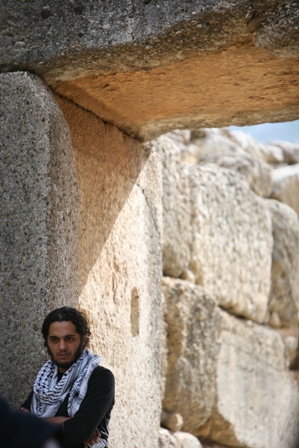The children of Palestine by Jad Salman
Introduction
The original Kids' Guernica mural was stolen from his house just days before his departure. He asked the children to improvise and to paint their ideas on a simple sheet of brown paper. It depicts as a message in several parts weapons, tanks, an ambulance, things children experience there daily. On the upper part, horizontally speaking or right across the entire length of the painting, there are abstract symbols mixed in with a half moon.
As an artist and graphic designer he wants to inspire children to uphold the human spirit - an almost impossible task under those conditions. He fears that the Palestine narrative is slowly disappearing. It is, poetically speaking, as if all traces of history of the Palestine people have been expelled to the desert and left there to the winds sweeping over the sand to leave behind just sculptured landscapes in silence.

Interestingly enough, when Jad Salman met Michael D. Higgins at the ECCM Symposium, Michael D. Higgins told him immediately that the Palestinian story is one of the hardest to tell.
Hatto Fischer
Children from Ramallah 2007
Children of Palestine
The mural was made by seven Palestinian children. It was a mixed group, with one child coming from Gaza while the others from Turlkarem, Jenine, Qalqili, Jerusalem. This reflects the fact that Ramallah like the whole of Palestine is composed of people coming from many different backgrounds and all living together.
Ever since I had a first encounter with Kids' Guernica in Torino while there on an artist residency program in 2005, I wanted to realize a similar action in Palestine.
What touched me most in this action in Torino was that a mixed group of youngsters from many countries, but all touched by war, tried to relate to Picasso's Guernica in a collective way to make their pains more understandable. Most impressive was for me when lying on the ground and seeing different feet - black, white, brown etc. - walking over the empty canvas.
It was up there in the mountains near Torino, all covered in snow, where the youth had gathered to discuss how to uphold the Olympic Truce and with it Human Rights during the Olympic Games, and this in preparation of the Winter Olympics in Torino 2006, that I met as well Hatto Fischer. His NGO called Poiein kai Prattein ("to create and to do") had together with PEACE WAVES organized this Youth event. It turned out later that it was also his first encounter with Kids' Guernica.
After Torino Hatto and I stayed in contact and thus I learned that he was preparing together with Spyros Mercouris for October 2007 a symposium about 'Productivity of Culture' in Athens and this in conjunction with a Kids' Guernica exhibition.
Knowing this, I brought together children in my neighborhood to see if we could create together a mural based on what Guernica means to them. Circumstances did not allow the children to express themselves on a canvas which has the same size as Picasso's Guernica (7,8 x 3,5 m), but on a smaller format. However, the full intention was there to express all agonies about war and peace, about life between dream and reality and about hardships in daily life.
Thanks to a new art residency which brought me to Paris by the end of September 2007, I could bring with me the little mural to France with the intention to send it from to Athens. Fortunately after having arrived in Paris, I learned that my visa permitted me to travel in Europe and therefore I could take up the invitation by the organisers of the event in Athens and bring the mural personally in October 2007.
What strikes me most about what the children painted on this little mural, is their effort to imagine a normal life which includes contact with the sea, land and sky. But that was not normal to them because in the sea they saw destroyers, on land tanks and in the sky airplanes dropping bombs. Even the moon seems to be threatened by bombs. Despite of this situation it did not stop them to imagine happiness. This they portrayed in the mural as a figure dancing with balloons. Interesting is that the mural contains an element of Picasso in the form of hand calling for help. This hand stretches out towards an ambulance which is to be found below a tank and helicopter.
All children growing up in war learn very quickly that the only person they can rely upon is themselves. They face a shortcut in life; not only a short childhood, but also a short life.
What this mural says very simply is that children search for a normal life.
Jad Salman - Artist, Palestine

Jad Salman
« Dubai by Sara Lowndes | Blind Boys by Asit Poddar »

